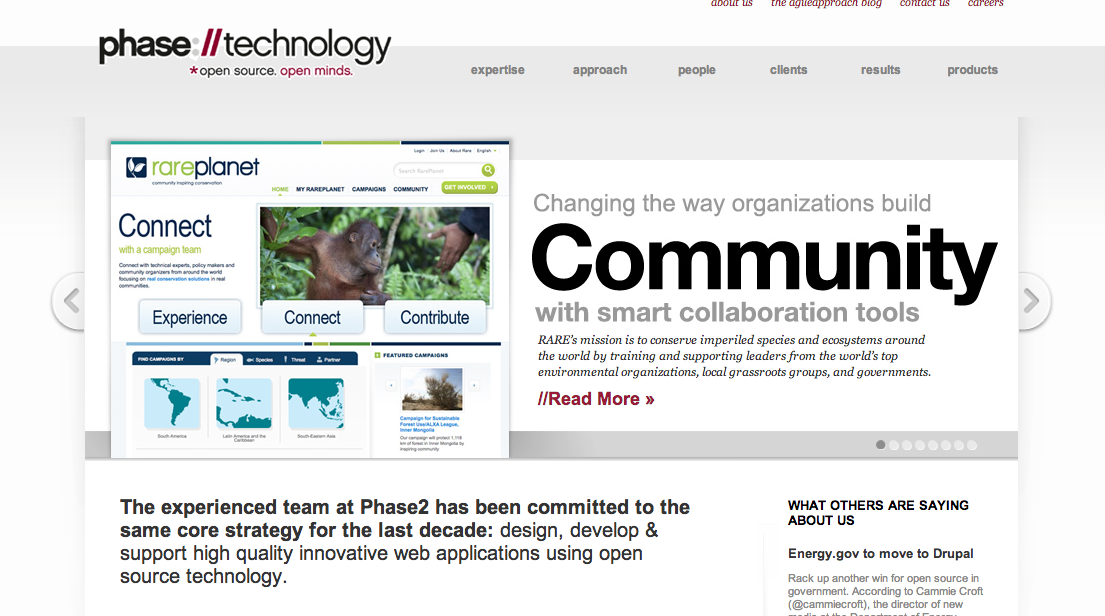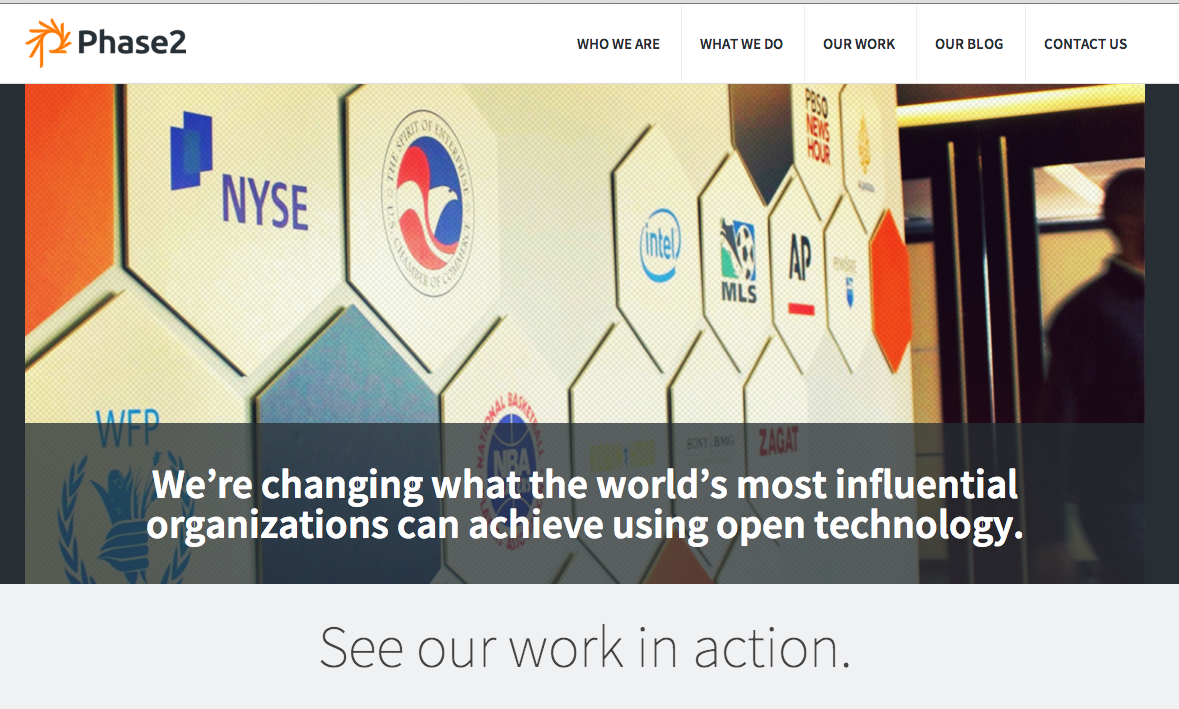I was surprised when I heard that Phase2 Technologies, a well-known Drupal service provider, had launched their main promotional website on WordPress. The article itself got quite a few comments.
Purely in terms of the final product, the site is really nice. It's both visually appealling and engages you to explore various aspects of their company. It successfully communicates tons of info in a clear and concise way, while also telling the fuller story of the people and previous projects. Bref, it's a great site and truly does them justice.
What bothers me slightly is their justification of a technology choice when the end result largely reflects a visual redesign.
(I'll admit that this post is less "meaty" than some of my previous Drupal writings. It's not really a critique of Phase2, but a way of questioning slightly their "technology choice" when in reality is somewhere in the realm of "design choice".)
Phase2's Evolution
Most web companies that have been around for a long time will be able to show quite the evolution through their own site. In fact, an individual site helps show us the evolution of web design standards as a whole. Phase2's progression is no different. Let's take a look at their site through the Way Back Machine.
Circa 2002...
Circa 2011...
Circa 2013...
Phase2's Stated Reasons for their Move to WordPress
I recently migrated my personal blog site off of WordPress and onto Octopress/Jekyll. I really enjoyed the experience of going through a new technology and feeling my way through their rendering/templating engine. It was a challenge in a few ways. For me, this truly was a way to get familiar with a new technology. While I did a bit of work tweaking the design, I was mostly interested in getting the content into a new setup as well as spending some time re-reading my old articles and cleaning up the text and media resources.
In their blog about their move to WordPress, Phase2 summarizes their choice of using WordPress as follows:
- ease of use for content admin
- quick implementation for a presentational site
- opportunities for team to get experience in a new area
I guess all of these reasons make sense. At the same time, I wonder if the real reason is slightly different and speaks more to the importance of design in today's world wide web. Many companies like Google, Facebook and others are clearly focusing more and more on the design and usability of their products.
In my opinion, in talking about it as a technology choice, they failed to speak of the importance of the design choice.
Visual Impact: Some Follow Up Questions
Phase2's main justificiation for using WordPress was the ease of content management. I think they didn't state the main goal of their new site: creating more visual impact. In the end, they skipped two huge discussions that would have been a lot more interesting to hear: 1. the design process and 2. pro's / con's of designing with wordpress over X.
These are discussions in the Drupal community and web development space in general that we need more of: how to design and how to implement our designs in X technology.
A Question: What was the process to reach this design?
Phase2's new site shows that a lot of design work went into the new site. The previous sites from 2002 to 2011 felt more developer-oriented. These old sites weren't bad and conveyed their info, but didn't really speak beyond that. The new site is really "purdy" and shows the general tendancy towards better and better web design. It's visual story telling.
As a Drupal developer who dabbles in design, I would have loved to know more about the process it took between different folks to get to this new look. It's definitely where the real work happened, I think.
I'd also like to know more about how a developer-centered company designs for themselves and for marketing to their potential customers. For example, I think clients would like to know: how was this design created?
A Question: What made WordPress easier (or not) to adapt this design?
I applaud Phase2's courage to do something outside of Drupal, even though I imagine the majority of their work is with and for Drupal. At the same time, with all that experience building and designing for Drupal, I'd like to know what were the advantages of building their newly designed site with WordPress over X other technology.
Assuming the design work came first, which is generally how these things go, then it's logical to wonder why WordPress made sense for bringing that design to life.
Anyone who has adapted designs and html conversions to Drupal knows how hard it can be to get a great design looking equally great with Drupal. Drupal spits out tons of markup. WordPress is indeed easier since their is much less html to battle against. But it's not always easy either.
The easiest way with the least amount of headaches for putting a visual design into live browser action is plain, old html.
This is largely why we at my company generally take designs and initially convert them to html and css. From there, we adapt it for the particular technology we plan to use, whether it's WordPress, Drupal, node.js or whatever. Design first. Convert to HTML/CSS second. And third integrate it with the related technology.
Finally, I'd like to know more their experience bringing a design to reality. What made WordPress easier to look great over Drupal? Or did it? For a site that's largely a static presentation, why not use Jekyll?
Let's start talking less about the technology choices and more about the processes of bringining solutions to reality.




